 |
 |
|
|
|
  |
Landmarks and Historic Locations
Koichi Kishi Historic Residence
Moto Osaka City Sakuranomiya Official Assembly Hall ,9, Amijimacho, Miyakojima-ku, Osaka
|
Koichi Kishi who was active in the dawn of Western style music in modern Japan, was born in 1909 and spent his childhood years in Miyakojima-ku.
Enraptured by his mother's violin, Koichi entrolled in the Swiss National Music Academy in 1926, and 2 years later studied in Berlin.
Though he came into possession of a valuable Stradivarius that once belonged to the English Royal Family, Koichi turned to conducting and composing. He became close friends with the twentieth Century's greatest composer, Furtwangler and in 1934 conducted the Berlin Philharmonic Orchestra.
His opus, "Taketori Monogatari" was performed at the late Professor Hideki Yukawa's celebration banquet for being the first Japanese recipient of a Nobel Prize. The tune is also used in the chimes of the Miyakojima Ward Office so please, have a listen.
After returning to Japan he continued to be active in the national musical community and great expectations were placed on him but he succumbed to disease and passed away on November 17, 1937 at the age of 28.
Currently not open to the public
|
 |
Fujita Museum of Art
10, Amijimacho, Miyakojima-ku, Osaka |
Denjaburo Fujita who made his fortune in the mines during the Meiji-era and was active in the modernization of Osaka's industries, used his personal fortune to accumulate a collection of tea ceremony utensils and artwork.
The majestic manor built in 1909 was destroyed in fire during World War II but the surviving storage house has been converted into an art museum for public exhibition.
"Murasaki Shikibu Nikki Ekotoba" heading the list of 9 National Treasures and 50 pieces of Important Cultural Assets are among the 5000 pieces of art in the collection that is said to be among the premiere class within the nation.
|
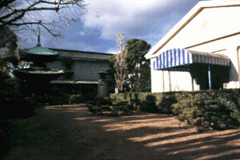 |
Kyobashi
1-5, Katamachi, Miyakojima-ku, Osaka
|
Known as the hub where JR, Keihan Line and the Subway meet, and for the presence of east Osaka's busy streets, the area takes its name from the Kyobashi bridge that spans the Neyagawa River to the north of Osaka Castle.
Found at the starting point of the Kyogaidou road, which means the bridge leading to Kyoto, was in times past filled with individuals making the pilgrimage to Nozaki.
|
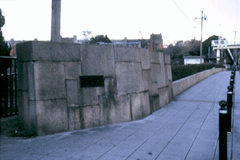 |
Sakuranomiya
1-12, Nakanocho, Miyakojima-ku, Osaka |
Originally located in Higashinari-gun Nota Village, the Shinto shrine was washed away by the flooding of the Yamato river in 1620 and was relocated to its current location in 1756.
Due to numerous fires holy treasures and old records have been lost.
Since the Edo period the surrounding area has been known for its cherry blossoms which people often come to see and in March 1923 was opened to the public as Kema Sakuranomiya Park, where it is loved by the citizenry throughout the four seasons.
|
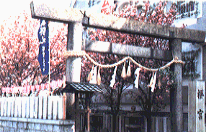 |
Nuezuka
3-18, Miyakojimahondori, Miyakojima-ku, Osaka
|
In 1153, Yorimasa Genzanmi slew a creature called the "Nue", that was troubling the Emperor by appearing nightly in the palace, with an arrow. The Nue had the head of an ape, the torso of a raccoon, the limbs of a tiger and the tail of a serpent.
The Nue was put on a log canoe which was set adrift on the Yokokawa River. It came to shore at Kasugae (currently the area around Miyakojima Hondori) where the villagers, fearing a curse, ritually buried the Nue. This burial mound came to be known as the “Nuezuka.”.
Thie Nue is also utilized as the design for the crest of Osaka Harbour.
|
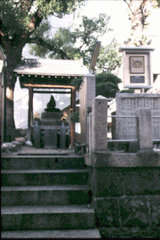 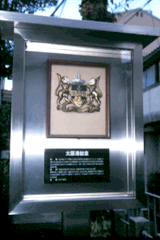 |
Miyakojima Shinto Shrine
1-5, Miyakojimahondori, Miyakojima-ku, Osaka
|
In this site where numerous floods from the Yodokawa River ravaged the land, the people of 8 villages gathered to build this shrine for the guardian god of the locality in 1160.
Within the grounds is the stone based Mie Hokyo Into, from the Kamakura period and as the most ancient stone artefact in the city, has been given Important Cultural Artefact designation for Osaka Prefecture.
|
 |
Kema Dam
3, Kemacho, Miyakojima-ku, Osaka |
Osaka's lifeline the Yodokawa River, has suffered countless floods and in 1885 suffered the worst flood in recorded history.
Learning from the disaster, in 1909 construction of the New Yodokawa River was completed and on the Old Yodokawa River dams were constructed under the design of Johannis de Rijke a Dutch engineer and is said to utilize the finest techniques of the period and represents the beginning of our nation's modern aquatic construction.
|
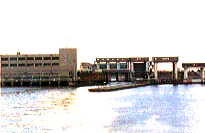 |
Birthplace of Buson
Kema Teibojo, 3-7, Kemacho, Miyakojima-ku, Osaka
|
Poet and artist, Buson Yosa, who left an indelible mark on the history of Japanese art and literature was born in 1716 in Kema village.
On the Yodokawa River embankment monument are the words "Spring winds, the embankment lies long and home is distant", from the famous "Shunbubateikyoku" which was written expressing a longing for Kema Village, carved as an enlargement of Buson's own handwriting.
The current monument was created in 1980.
|
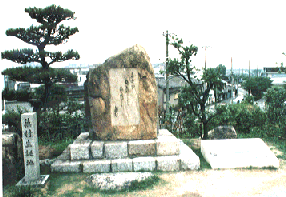 |
|
 |
|
 |
|
 |
